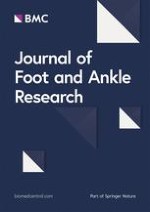Background
Ultrasound has shown promise for detection of sub-clinical disease in JIA. This may be particularly beneficial for the foot and ankle joints, which are difficult to examine in children. Early detection of sub-clinical foot disease permits earlier intervention which may improve outcome. The aim of this study was to evaluate agreement between clinical and ultrasound examinations of foot disease in JIA.
Methods
Thirty patients with JIA underwent clinical and US examination of 24 foot joints, 10 tendons and 6 peri-articular soft tissues. Each site was examined independently by a rheumatologist and a podiatrist for synovitis, and tenderness/swelling. At the same sites the sonographer examined independently for effusion, synovial hypertrophy, power Doppler signal (PS), tenosynovitis, or abnormal tendon thickening. Agreement was estimated using Cohen’s unweighted kappa (κ) (>0.4 = moderate agreement) with associated 95% confidence intervals.
Results
720 joints, 300 tendons and 180 soft tissue sites were assessed. Clinically detected synovitis, tenderness and swelling were recorded in 42 (5.8%), 78 (10.8%) and 73 (10.1%) joints respectively. US-detected effusions, synovial hypertrophy and PS were recorded in 88 (12.2%), 47 (6.5%) and 12 (1.7%) joints. Tenderness and swelling were recorded in 29 (9.7%) and 16 (5.3%) tendons and 28 (15.6%) and 9 (5%) soft tissues. US-detected tenosynovitis and PS were detected in 7 (2.3%) and 6 (2%) tendons. Abnormal thickening of the plantar fascia origin and Achilles tendon insertion were detected at a frequency of 4/60 (6.7%) and 1/60 (1.7%), and 3/60 (5%) effusions were recorded at the retro-calcaneal bursa. Subclinical foot disease was discovered in 52 (7.2%) joints, 5 (1.6%) tendons and 4 (2.2%) soft tissue sites. Agreement was consistently less than moderate (κ<0.4) for each clinical and US interaction. There was moderate agreement between the rheumatologist and podiatrist for active synovitis versus joint swelling (κ=0.52).
Conclusions
There is frequent discordance between clinical and US assessments of foot disease in JIA. Subclinical foot disease appears common; however clinical examination also detected features of active disease in structures that were recorded as normal on US. These findings suggest US may be a useful tool to aid clinical examination of the foot in JIA patients.
This article is published under license to BioMed Central Ltd. This is an open access article distributed under the terms of the Creative Commons Attribution License (
http://creativecommons.org/licenses/by/2.0), which permits unrestricted use, distribution, and reproduction in any medium, provided the original work is properly cited.
